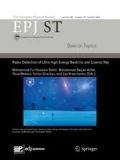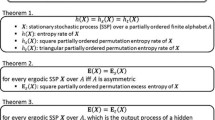Abstract
The coupling complexity index is an information measure introduced within the framework of ordinal symbolic dynamics. This index is used to characterize the complexity of the relationship between dynamical system components. In this work, we clarify the meaning of the coupling complexity by discussing in detail some cases leading to extreme values, and present examples using synthetic data to describe its properties. We also generalize the coupling complexity index to the multivariate case and derive a number of important properties by exploiting the structure of the symmetric group. The applicability of this index to the multivariate case is demonstrated with a real-world data example. Finally, we define the coupling complexity rate of random and deterministic time series. Some formal results about the multivariate coupling complexity index have been collected in an Appendix.
Similar content being viewed by others
References
L. Glass, Nature 410, 277 (2001)
G. Tononi, G.E. Edelman, Science 282, 1846 (1998)
S.H. Strogatz, et al., Nature 438, 43 (2005)
C. Bandt, B. Pompe, Phys. Rev. Lett. 88, 174102 (2002)
J.M. Amigó, M.B. Kennel, Physica D 231, 137 (2007)
M. Staniek, K. Lehnertz, Phys. Rev. Lett. 100, 158101 (2008)
R. Monetti, W. Bunk, T. Aschenbrenner, F. Jamitzky, Phys. Rev. E 79, 046207 (2009)
J.M. Amigó, R. Monetti, T. Aschenbrenner, W. Bunk, Chaos 22, 013105 (2012)
T.M. Cover, J.A. Thomas, Elements of Information Theory (John Wiley & Sons, New York 1991)
W. Bunk, T. Aschenbrenner, et al. (2009) e-print [arXiv:physics.med-ph/0905.3911v1]
J.A. Swets, Psycological Bull. 99, 100 (1986)
J.M. Amigó, Physica D 241, 789 (2012)
T. Haruna, K. Nakajima, Physica D 240, 1370 (2011)
J.M. Amigó, L. Kocarev, J. Szczepanski, Phys. Lett. A 355, 27 (2006)
J.M. Amigó, M.B. Kennel, Physica D 237, 2893 (2008)
J.M. Amigó, Permutation Complexity in Dynamical Systems: Ordinal Patterns, Permutation Entropy, and All That (Springer Verlag, Berlin, 2010)
Author information
Authors and Affiliations
Corresponding author
Rights and permissions
About this article
Cite this article
Monetti, R., Amigó, J., Aschenbrenner, T. et al. Permutation complexity of interacting dynamical systems. Eur. Phys. J. Spec. Top. 222, 421–436 (2013). https://doi.org/10.1140/epjst/e2013-01850-y
Received:
Revised:
Published:
Issue Date:
DOI: https://doi.org/10.1140/epjst/e2013-01850-y




